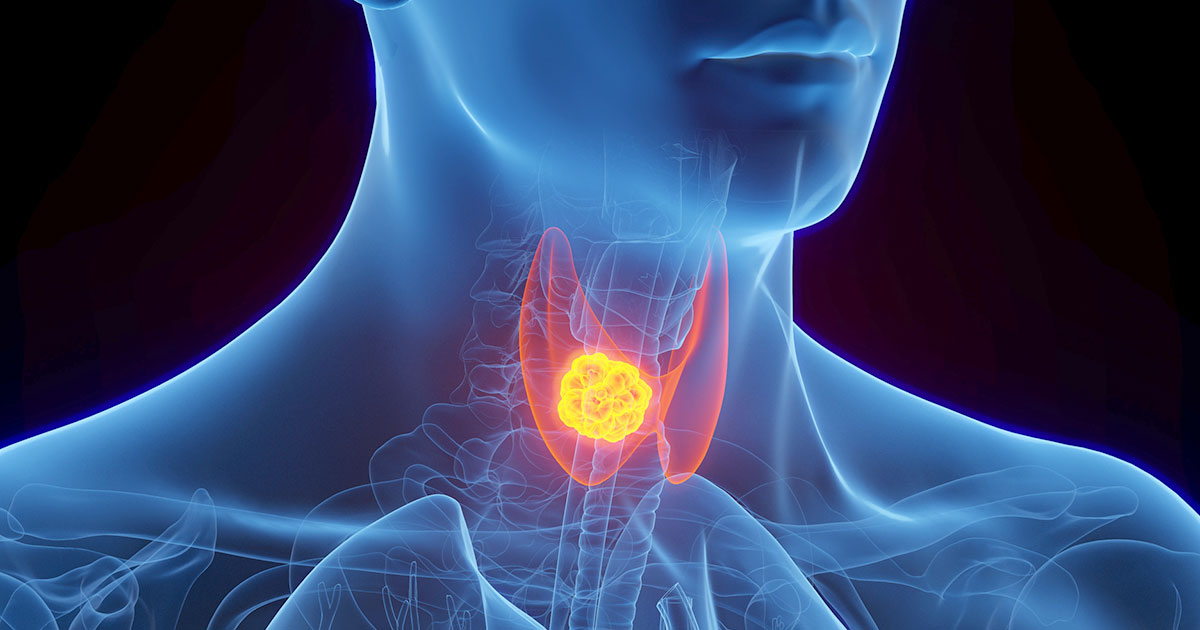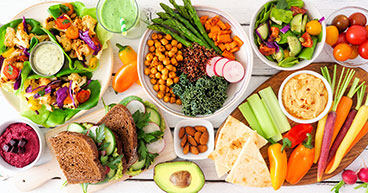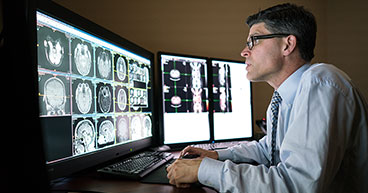
When you have cancer, you want to do everything you can to maintain a good quality of life and improve your chances of a positive treatment outcome. For people with certain types of cancer, that may include eating a restrictive diet for a short period of time.
This is especially true for patients with thyroid cancer. The two most common types of thyroid cancer—papillary and follicular—are often treated with radioactive iodine therapy, which is designed to destroy cancer cells that absorb iodine. But to help improve the effectiveness of the therapy, patients are often asked to significantly reduce the amount of iodine in their diets before starting treatment, leading to a few weeks of a potentially bland and hard-to-follow meal plan.
Dietitians may be able to help, especially those who have experience with cancer patients. Nutritional support is often part of a patient’s care plan and may include recipes and meal-planning tips that won’t make following a low-iodine diet so grueling.
In this article, we’ll explore:
- What is thyroid cancer?
- Why should some thyroid patients follow a low-iodine diet?
- What is a low-iodine diet?
If you’ve been diagnosed with cancer and are interested in a second opinion on your diagnosis and treatment plan, call us or chat online with a member of our team.
What is thyroid cancer?
The thyroid gland is the small, butterfly-shaped gland in your neck. The thyroid performs several important roles in the body, including producing the hormones that control body temperature, weight, energy levels and heart rate.
Thyroid cancer, the 12th most common cancer diagnosed in the United States, develops when cells in the thyroid mutate and replicate, eventually forming a tumor. The American Cancer Society estimates more than 44,000 new cases will be diagnosed in the United States this year. Papillary thyroid cancer is the most common form of the disease, accounting for roughly 80 percent of all cases. Papillary cancers tend to grow slowly, but often spread to the lymph nodes in the neck.
The second most common type of thyroid cancer, follicular thyroid cancer, makes up about 1 percent of cases. Follicular cancers don’t usually spread to the lymph nodes, but may spread to other parts of the body, such as the lungs and bones.
In general, thyroid cancer is highly treatable and has a five-year relative survival rate of close to 100 percent when it’s confined to the thyroid or has only spread to nearby areas.
The main treatment is surgery, including procedures to remove either part of the thyroid or the entire gland. Another common treatment, however—especially if the cancer has spread to the neck or other parts of the body—is radioactive iodine therapy.
Why should some thyroid cancer patients follow a low-iodine diet?
Iodine is a mineral the thyroid needs to make hormones. But iodine only comes from what you eat and drink. Most of that comes from iodized salt or other foods that have iodine added to them. Iodine may also be found naturally in seafood, egg yolks, beans and certain fruits.
Radioactive iodine therapy works by depleting the amount of iodine you get from your diet so your thyroid will instead absorb radioactive iodine, which can destroy thyroid cancer cells that were missed by surgery or that spread to the lymph nodes or other parts of the body.
“The purpose is to make your thyroid hungry for iodine so the radioactive iodine therapy is more effective,” says Lora Reeves, MS, RD, LD, Clinical Oncology Dietitian, City of Hope® Cancer Center Atlanta.
How long should you stay on a low-iodine diet?
Recommendations will vary depending on the individual’s circumstances, however, most oncologists recommend their thyroid cancer patients follow a low-iodine diet for two weeks before starting radioactive iodine therapy and for one to three days afterward, Reeves says.
“We’ll know ahead of time that a patient’s treatment plan is going to include radioactive iodine therapy, so we’ll help patients learn what a low-iodine diet entails and get them where they need to be,” she explains.
Because it reduces a mineral the body needs for several important functions, a low-iodine diet isn’t recommended unless your doctor prescribes it. And you also shouldn’t stay on the diet longer than your doctor tells you. In addition to reducing your body’s necessary supply of iodine, it may lead to other nutrient deficiencies.
What is a low-iodine diet?
Following a low-iodine diet is simply reducing the amount of iodine you consume for a medically necessary length of time, Reeves says. The goal is less than 50 micrograms (mcg) of iodine per day. (That’s compared to the recommended 150 mcg daily allowance of iodine for most adults.)
Think of it as a daily “budget.” The goal is to limit overall iodine consumption, which requires knowledge of which foods contribute in high amounts to your daily total of 50 mcg. The American Thyroid Association recommends:
- Avoiding foods high in iodine (more than 20 mcg per serving)
- Limiting foods that are moderate in iodine (5 to 20 mcg per serving)
- Enjoying foods that are low in iodine (up to 5 mcg per serving)
People sometimes confuse a low-iodine diet with a low-sodium diet because most Americans’ iodine consumption comes from table salt, which contains extra iodine to combat goiter, or an enlarged thyroid, she says. One tablespoon of iodized salt can contain more than 400 mcg of iodine, in fact. But low-iodine and low-sodium diets aren’t the same thing. People following a low-iodine diet can still eat salt as long as it has no added or naturally occurring iodine. (Hint: Sea salt contains naturally occurring iodine, so it’s best to avoid it.)
What can you eat on a low-iodine diet?
When you’re following a low-iodine diet, it can be hard to know what to eat and what to avoid, and it can be even harder to achieve variety.
"When attempting to stay under 50 mcg per day of iodine, you could just eat raw fruits and vegetables, which are low in iodine. However, this will likely just lead to you feeling hungry and tired of eating fruits and vegetables, as well as removing key nutrient including protein and fat from your diet” Reeves says, adding that that’s why she usually shares some meal-planning pointers with her patients.
Foods to eat:
- Coffee and tea (fresh brewed, not instant)
- Egg whites
- Fresh fruits
- Vegetables, preferably raw or frozen
- Fresh meats, like chicken, turkey, beef, pork and lamb (up to 5 or 6 ounces per day). Whole cuts contain less iodine than ground meats
- Freshwater fish
- Grains, cereals, pasta and rice that have no high iodine ingredients (up to four servings per day)
- Gelatin, sorbet and popsicles without red dye No. 3
- Jelly, honey and maple syrup
- Most sodas, except those with red dye No. 3
- Olive oil and vegetable oil
- Skinless potatoes
- Uncured meats
- Unsalted canned beans
- Unsalted nuts and nut butters
- Vinegar
Foods to limit or avoid:
- Blackstrap molasses
- Canned fruits, like peaches, pears and maraschino cherries
- Celery, garlic, onion and seasoned salts
- Commercial protein shakes, like Ensure and Boost
- Cured meats
- Egg yolks
- Instant coffee and tea
- Iodized salt
- Medications and food dyes that contain red dye #3
- Milk and dairy products
- Most seafood
- Organ meats, like liver and intestines
- Potatoes with skin
- Processed foods
- Salted nuts
- Sea salt
- Seasoning mixes, like adobo
- Seaweed
- Sodas that contain red dye #3
- Soy products
- Store-bought breads and bakery products
Remember that these are general rules of thumb and not ironclad, Reeves says. You should always make sure that what you’re eating doesn’t contain iodized salt.
Patients may consider referring to any of the multiple thyroid-friendly cookbooks for guidance.There are plenty of recipes are out there to help you. Reeves, for example, shares the “Low-Iodine Cookbook” from the Thyroid Cancer Survivors’ Association with her patients. The cookbook breaks down what you can eat and shows you which foods fall into which categories.
“You have to get really good at looking at nutrition labels,” she says, adding it can be easier to prepare your own meals while on the diet. “Going to restaurants can be especially tricky because most prepare their food with iodized salt.”
Also, Reeves says, watch out for vitamins and dietary supplements that have iodine, such as calcium supplements, which can contain crushed-up oyster shells. “Always bring your vitamins supplements to your doctor to check whether they contain iodine,” she adds.
“You do have to be mindful while you’re on a low-iodine diet,” Reeves says. “It’s a restrictive diet , and there are a lot of things in the no-fly zone, which can make maintaining variety in your diet hard. But the positive to keep in mind is that it’s making your treatment more effective, and it’s not forever.”
Supportive care for thyroid cancer patients
In addition to causing dietary disruptions, many thyroid cancer treatments, including radioactive iodine therapy and surgery, can cause side effects such as pain and neuropathy.
To manage those side effects, your care team may advise supportive care therapies to help you recover from your treatments. For instance, you may need to take daily hormone supplements to maintain your body’s normal metabolism if you’ve had most or all of your thyroid gland removed. Your care team will work with you to address any side effects, reduce the potential for treatment delays and get you back to living your life as quickly as possible.
If you’ve been diagnosed with cancer and are interested in a second opinion on your diagnosis and treatment plan, call us or chat online with a member of our team.


